 |
||
|
||
| ||
 X-mas is the time of mass sales of everything, including 3D accelerators. It's high time for all companies to hurry up and to launch the Titanium based cards if they haven't done it yet, otherwise, the monsters will eat up their share. We have already examined several NVIDIA Titanium based cards, but we haven't yet taken a look at the Taiwanese giant ASUSTeK. Unfortunately, it lost the palm in releasing its new products. Moreover, its prices are higher than the competitors' ones. But ASUS has always been famous for the most complete lines of NVIDIA based products. That is why today we will study a wide set of new video cards - "Titans" (though it is not complete). I hope you will get an idea on new products from ASUSTeK and will be able to make a correct choice of video cards on GeForce2 Ti, GeForce3 Ti 200 and 500. Some time ago I wrote about the Titanium line. If you remember, the GeForce2 Ti cards are the most boring (ASUS AGP-V7700TI). The difference between the GeForce2 GTS/Pro and GeForce2 Ti is only in a processor's frequency: 200 MHz for the former and 250 MHz for the latter. Like the GeForce2 Pro cards, the "Titans" come with a DDR memory working at 200 (400) MHz. And the GeForce3 processor (like its brothers Ti 200/500) is quite interesting, especially considering that it is the latest generation of GPUs from NVIDIA. That is why before we turn to the GeForce2/3 Titanium I should remind you that the whole theoretical base connected with the GeForce3 is concentrated in the following articles (here you can also learn the peculiarities of certain cards and find out how they operate in the latest benchmark tests).
So, today we will consider several cards: 2 on the GeForce2 Ti and 3 on the GeForce3 Ti 200/500:
As you can see, it is only ASUS AGP-V8200T2 Deluxe which is lacking, but taking into account that it has the same additional functions as the ASUS AGP-V8200T5 Deluxe, you shouldn't be disappointed. CardsASUS AGP-V8200T2The ASUS AGP-V8200T2 card is based on the NVIDIA GeForce3 Ti 200 and has an AGP x2/x4 interface, 64 MBytes DDR SDRAM located in 8 chips on the right side of the PCB. 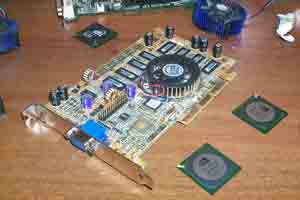 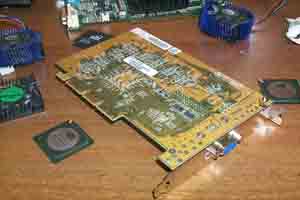 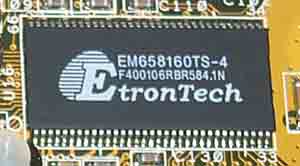 EtronTech produces memory chips with 4 ns access time, which corresponds to 250(500) MHz. As you can see, even such an obedient company as ASUSTeK releases its card with a faster memory than the 5 ns one recommended by NVIDIA. But as it lacks for additional cooling, the overclocking potential isn't be high. However, 4ns memory can overclock at least to the rated frequency of 250 MHz; and EtronTech is rather popular with fans of 3D accelerators because of high overclocking potential comparable with EliteMT (ESMT). ASUSTeK has its own design which provides for multimedia devices (VIVO, 3D glasses). And even Pure cards which lack such details have places for mounting the corresponding chips and connectors. Just look at the ASUS AGP-V8200T2: ASUS AGP-V8200T2  NVIDIA GeForce3 Ti 200 reference card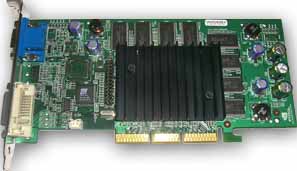 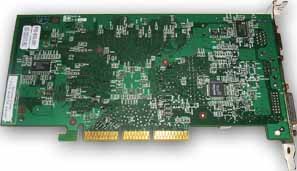 ASUS AGP-V8200T5 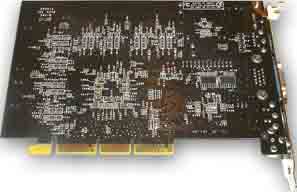 Its design differs much from the reference one and follows its elder brother - ASUS AGP-V8200T5. The difference is only in a PCB color. As you remember, the GeForce3 cards had black textolite, and now the company comes back to the yellow one. Maybe thus they set apart junior and elder models. The ways the chip and the memory are cooled are different for these cards. The ASUS AGP-V8200T5 is equipped with heatsinks on the memory modules and a central large cooler for the GPU, and the T2 cards have a small (but efficient) cooler on the graphics processor and that's all. Overclockers would hardly like such card without heatsinks on the memory. Like all ASUS cards of the latest generation, this one has a status monitoring support based on the SmartDoctor technology: it provides information on a temperature mode of the card and a rotational speed of the cooler, and it protects the card from overheating. But in a 2D mode the SmartDoctor utility decreases the card's frequencies lower than the rated ones, but doesn't do it always correctly, thus causing some artifacts on a screen. The ASUS AGP-V8200T2 has neither TV-out nor DVI.  The card ships in a Retail package. Accessories:
OverclockingThe ASUS AGP-V8200T2 reached a good result in overclocking the core and the memory- 220/260 (520) MHz. Though it didn't catch up with the Ti 500 :-). But at least, lack of heatsinks on the memory didn't prevent from reaching the level of GeForce2 Ultra card (which had 4ns memory cooled). Note:
ASUS AGP-V8200T5 and AGP-V8200T5 DeluxeThese cards are based on the NVIDIA GeForce3 Ti 500 and have an AGP x2/x4 interface, 64 MBytes DDR SDRAM located in 8 chips on the right side of the PCB. 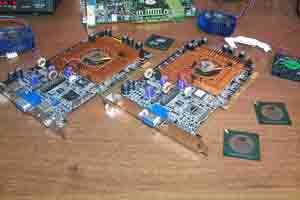  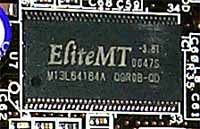 EliteMT produces memory chips with 3.8 ns access time, which corresponds to 263 (526) MHz. It is a usual memory installed on all GeForce3 cards. This memory worked excellently at 250 MHz and higher, that is why the developers decided to leave the 3.5ns memory aside which is set on the reference card GeForce3 Ti 500. The design, as you already know, is far from the reference one: ASUS AGP-V8200T5 Deluxe  NVIDIA GeForce3 Ti 500 reference card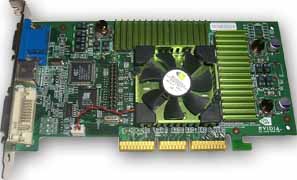 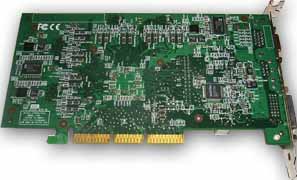 It makes no sense to show the non-Deluxe card as it just lacks TV-in/out connectors, 3D glasses and chips for VIVO. The ASUS AGP-V8200T5 has a design similar to the ASUS AGP-V8200/V8200 Deluxe. But the PCB is a bit shorter. And the layout is slightly redesigned since overclocking of the 3.8ns memory is possible up to 285-290 MHz (while earlier it was possible to reach only 275-280 MHz for GeForce3 cards). Like the ASUS AGP-V8200T2, the Ti 500 based cards are equipped with hardware monitoring based on the SmartDoctor technology. Now we are going to take a look at the Deluxe revision. Deluxe means a connector for stereo glasses (and the glasses themselves), unsoldered TV-in/out and the corresponding chip. Yet in spring I reviewed the ASUS AGP-V8200 Deluxe, where I briefly touched upon VIVO (Video-In Video-Out). At that time TV-in was almost useless because of the defective software. At last the developers released normal drivers for video capture for the Windows XP (ver.1.08 is available at http://www.nvidia.com). Besides, the cards are now coming with excellent programs from InterVideo - WinCoder and WinProducer. The first one controls the video capture and allows recording both whole video clips and separate frames:    You can estimate image quality obtained with the help of video capture (it is controlled by a multi-purpose processor from Philips of the 7100 series - ADC and DAC in one). This chip incorporates copy protection from MacroVision, that is why some video movies can be a little jerky when run through the ASUS AGP-V8200T5 Deluxe. Another program, WinProducer, is a clip editor:  I must say that the level of Video-In is much better now but it is still poorer than the VIVO from ATI. The ASUS AGP-V8200T2 has no DVI. ASUS AGP-V8200T5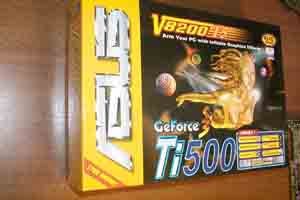  ASUS AGP-V8200T5 Deluxe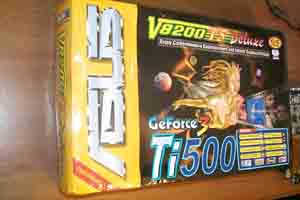   The cards ship in a Retail package. The Deluxe version comes in a plastic bag dressed in cardboard box which has a small window through which you can see the card. Accessories:
OverclockingThe ASUS AGP-V8200T5 (both cards) demonstrated rather good overclocking of the core and memory up to 255/285 (570) MHz. It is the highest possible overclocking level for such cards. Some samples can work at a frequency higher by 5-10 MHz, but there are quite few of them. Note:
ASUS AGP-V7700TI and AGP-V7700TI DeluxeThese cards are based on the NVIDIA GeForce2 Ti and has an AGP x2/x4 interface, 64 MBytes DDR SDRAM located in 8 chips on the right side of the PCB. 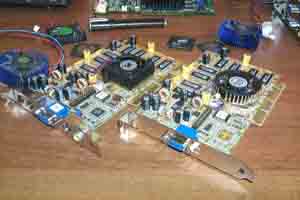 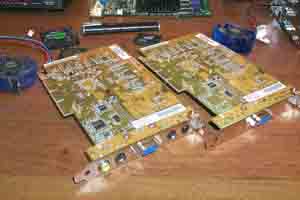 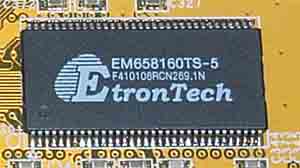 EtronTech produces memory chips with 5 ns access time which corresponds to 200 (500) MHz, and the memory works at this frequency. This time the company followed the NVIDIA's recommendations: such cards use a PCB from the previous cards on the GeForce2 GTS/Pro 64 MBytes. ASUS AGP-V7700TI Deluxe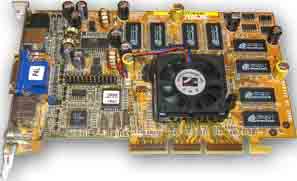 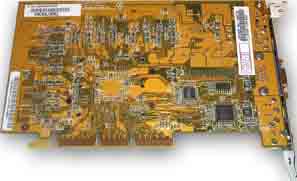 Chaintech AGP-RI93 (NVIDIA GeForce2 Pro reference card)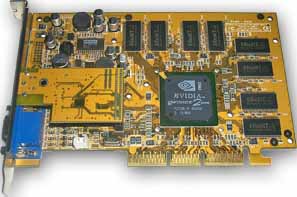 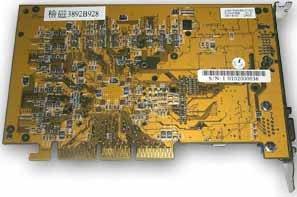 It makes no sense to show the non-Deluxe card as it just lacks TV-in/out connectors, 3D glasses and chips for VIVO. The fact that the new cards on the GeForce2 Ti use old sets of two chips (Chrontel for TV-out and Philips for TV-in) prove that they use old PCBs for these cards. The ASUS AGP-V7700TI is very close to the reference design for the GeForce2 Pro. The difference is that the card in question was developed with multimedia functions and SmartDoctor hardware monitoring in mind. I don't want to dwell on the TV-in function as it uses the same software as in the ASUS AGP-V8200T2/T5 Deluxe. ASUS AGP-V7700TI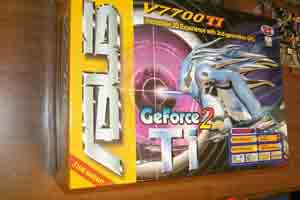  ASUS AGP-V7700TI Deluxe 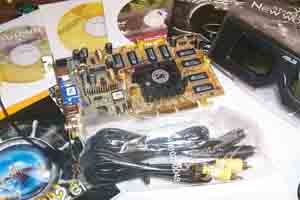 The cards ship in a Retail package. Accessories:
OverclockingThe ASUS AGP-V7700TI has a poor potential, and it makes no sense to overclock it. The ASUS AGP-V7700TI Deluxe has it much better - 290/220 (440) MHz, though it is also one of the lowest even for the GeForce2 Pro cards. Note:
Testbeds and driversTest system for the ASUSTeK cards:
The stands were completed with ViewSonic P810 (21") and ViewSonic P817 (21") monitors. In the tests we used NVIDIA drivers of v.21.85. VSync was off, S3TC was on. The cards come with the ASUS drivers of the v21.83. For the comparative analyses we used the following cards:
Test resultsIn 2D quality mode the ASUS AGP-V8200T2/T5 had an excellent image in 1600x1200 at 75 Hz (at 85 Hz the Deluxe revision had a little worse image). The GeForce2 Ti couldn't cope with such resolution even at 75 Hz, and only in 1280X1024 at 85 Hz and 100 Hz the quality was acceptable. For estimation of 3D quality we used:
In case of two revisions of one card (Pure/Deluxe) we give results of only one as they have an identical performance. Quake3 Arenademo002, standard modesThe tests with the demo002 were carried out in the High Quality mode (32-bit color). ASUS AGP-V8200T2/T5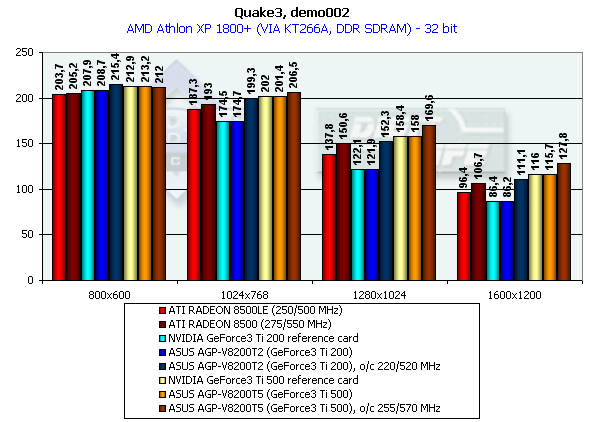 ASUS AGP-V7700TI 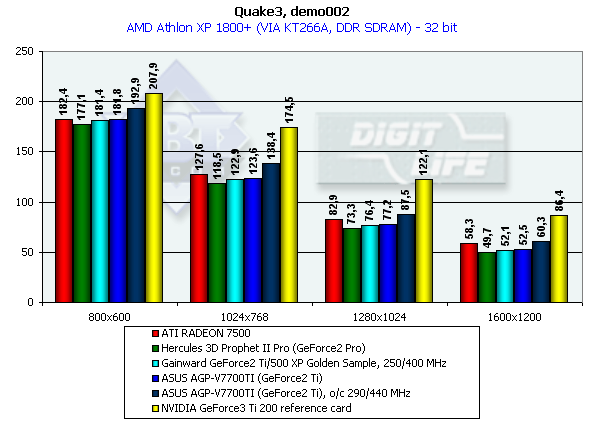 All these tests show that all the cards in question have the performance required for GeForce3 Ti 200/500 and GeForce2 Ti classes. As you can see, the Ti 200 loses to the ATI RADEON 8500LE and, of course, to the RADEON 8500, while the Ti 500 sweeps the field. It is interesting that the Deluxe which sells today - a revision of the Ti 200 card, outscores the RADEON 8500LE cards from ATI's Chinese partners. On the one hand, a higher price, lack of dual-monitor support, lower performance; on the other hand, VIVO, 3D glasses support, higher stability in games. So, it depends on your needs. The Ti 500 card, especially Deluxe, is too expensive, though it is better in speed and in accessories. The drawback is a lack of dual-monitor support. In the camp of GeForce2 Ti cards we can see outscoring of the ATI RADEON 7500 (290 MHz) in B 16bit color and equality with it in 32bit color. If you have a look at the prices you will see that a normal (290 MHz) ATI RADEON 7500 and ASUS AGp-V7700TI Deluxe are at the same level. And again, it is for you to decide, but the RADEON 7500 stands a better chance. Quaver, High Quality ModesThe tests were carried out in 32-bit color mode at the highest detailing level and with complicated geometry (r_subdivisions "1" r_lodCurveError "30000"). This benchmark loads an accelerator with geometry, large textures and huge effects. ASUS AGP-V8200T2/T5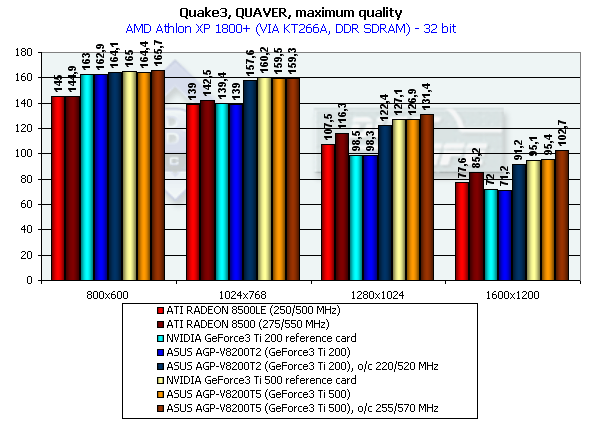 ASUS AGP-V7700TI 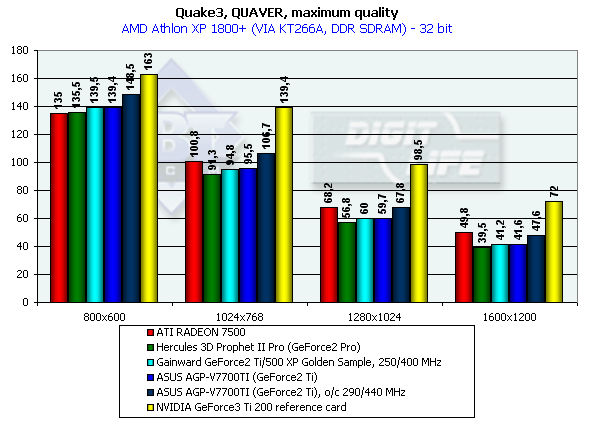 In this test the ASUSTeK cards have improved their position as compared with the ATI's ones. GiantsThe tests were conducted in 16- and 32-bit colors in the highest quality modes. ASUS AGP-V8200T2/T5 ASUS AGP-V7700TI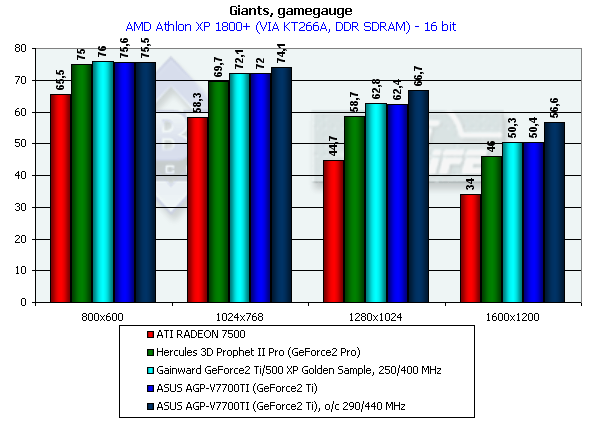 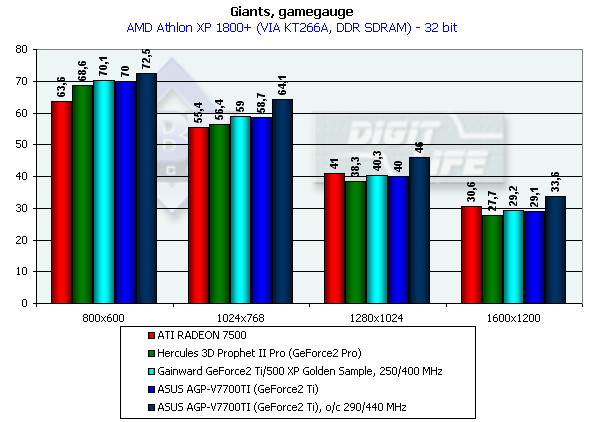 The ATI RADEON 8500 loses the battle, while the GeForce3 Ti 200 and Ti 500 cards are far ahead. The RADEON 7500 manages to catch up with the ASUS AGP-V7700TI in 32-bit color, though not in all resolutions. In closing, I'd like to advise you to read also other reviews of GeForce2/3 based video cards. Besides, in our 3Digest you can get thorough information on performance of these cards on different platforms. ConclusionIf we compare the ASUS cards with the other camp - ATI, we will see that they have almost equal forces (if we take into consideration deficiency of the Canadian cards, a fast landslide of prices for ASUS cards and an average performance of all the tests). And if we take competitors from the same camp, i.e. NVIDIA based cards from other manufacturers, the situation will be brilliant. Sure, it is necessary to pay for the brand name, but I think that the prices are too high. And the new cards from ASUS look paler than they could as compared with other majors (Leadtek, InnoVision, Gainward etc.). But it should be noted than nobody apart from ASUSTeK (and Gainward and MSI) do not supply cards with multimedia functions (MSI does provide 3D glasses but they serve only for images and clips, not for games).
The complete characteristics of video cards of this and other classes can be found in our 3Digest. Highs:
Lows:
Write a comment below. No registration needed!
|
Platform · Video · Multimedia · Mobile · Other || About us & Privacy policy · Twitter · Facebook Copyright © Byrds Research & Publishing, Ltd., 1997–2011. All rights reserved. |